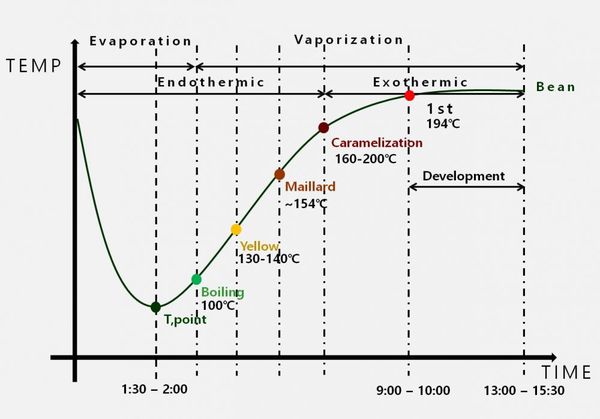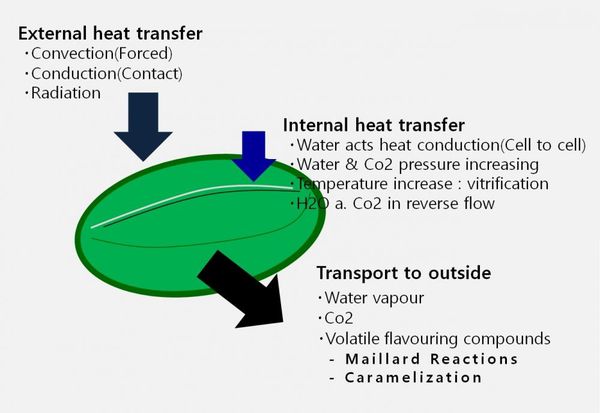Professional coffee roasting | is coffee roasting too complicated? A picture teaches you about the baking process.

For professional baristas, please follow the coffee workshop (Wechat official account cafe_style)
In his coffee roasting book Roasting Craft, South Korean Liu Chengquan uses a chart to divide the coffee roasting process (Roasting Process) into several important stages: adding beans, Turning Point, boiling, Yellow Point, Mena reaction, caramelization, first explosion (maybe into second explosion), beans, cooling.
Even if each baker develops a personalized baking curve and method according to his own habits and preferences, on the whole, the Roasting Process proposed by Liu Chengquan seems to be an inevitable model.
STEP 1. From entering beans to T.Point
Bean feeding is the initial stage of baking. after putting beans in a preheated drum, the drum temperature will drop immediately until the drum temperature and bean temperature reach balance. Generally speaking, it is appropriate to reach the T.Point (recovery point) within 120 seconds. If the temperature of the T.Point is too low, the time to reach the first explosion will be too long. On the contrary, the T.Point temperature is too high and the time to reach the first explosion is too short. Therefore, it is necessary to calculate the ROR to determine the temperature of the bean.
STEP 2. From T.Point to Yellow
After T.Point, raw beans enter the endothermic stage. 70% of the bean weight is made up of insoluble (Insoluble) cellulose (Cellulose). In order to transfer heat to the inside of the bean, the water conductivity is used. If the bean water content is low, the time to reach the Yellow stage will be shorter, on the contrary, if the bean water content is high, the time to reach Yellow will be longer.
Starting from the bean temperature of 100C, the water changes from Evaporation to Vaporization, and the vapor pressure and temperature inside the bean rise. At this time, the bean tissue undergoes vitrification (Vitrification) and begins to expand, destroying chlorophyll and entering Yellow.
STEP 3. From Mena reaction (Maillard Reaction) to 154.C
When the baking temperature reaches 154.C, the temperature and pressure inside and outside the beans are at about the same stage. The sugar components are decomposed into reducing sugars (Reducing sugar) by adding water, and then combine with amino acids (Amino acids) to produce melanin-like (Melanoidine) and volatile organic compounds (VOCs), which is the Mena reaction. Through this process, coffee beans will produce flavor changes.
STEP 4. From caramelization (Caramelization) 160.C to 200.C
At this stage, beans are caramelized by thermal decomposition, which begins to reduce sweetness and transform into a very complex flavor (Aroma). At the same time, due to the increase of CO2 pressure and vapor pressure, beans began to produce a febrile reaction.
STEP 5. From the first explosion to 1945.C
When the vapor pressure and CO2 pressure inside the bean accumulate, the first burst (1st Crack) occurs. The blow holes produced at this time becomes the outlet for the discharge of Flavor compounds inside the bean. At this stage, the beans are completely converted to a febrile reaction.
The first explosion is the critical Point in the whole baking process. From then on, the flavor of the affiliated Sugar Browning (Nutty, Caramelly, Chocolaty) will appear, and most bakers will estimate the "development rate" (DTR. Development Time Ratio) from this key point.
STEP 6. From the second explosion to 220. C
The CO2 pressure accumulated due to thermal combustion is discharged, and the beans burst again, which is called the second explosion. At this stage, the cell structure of beans begins to be destroyed, and the interior begins to be coked or carbonized (Carbon). From then on, the flavors attached to Dry Distillation (Resin, Spice, Carbon) will appear and produce obvious bitterness.
STEP 7. From bean production to Cooling
Although the beans begin to cool immediately after they are produced, the temperature of the beans will not drop immediately. Because the temperature inside the bean can be maintained at a high temperature for a period of time, the high temperature maintained by the bean itself may change the baking degree and may lead to the volatilization of the aromatic flavor. Therefore, rapid cooling is a very important step to maintain the flavor.

Original author: Liu Chengquan "Roasting Craft"
Important Notice :
前街咖啡 FrontStreet Coffee has moved to new addredd:
FrontStreet Coffee Address: 315,Donghua East Road,GuangZhou
Tel:020 38364473
- Prev

After reading these rumors about coffee, I was scared to wash Yega in a pot of water.
Professional baristas exchange please follow the coffee workshop (Wechat official account cafe_style) rumor one: drinking coffee is easy to get fat? Truth: the word coffee comes from the Greek word Kaweh, meaning strength and passion. In fact, the calorie of coffee itself is very low, black coffee (black coffee) is very small, a cup of 100 grams of black coffee has only 2.55 calories. The largest calorie in coffee is one of them.
- Next

[coffee tips] how do you get healthy coffee when you go out to work, travel, walk?
The exchange of professional baristas Please pay attention to the Coffee Workshop (Wechat official account cafe_style) Modern people are so busy at work that they are often unable to grind beans and brew coffee by themselves every day. Fortunately, there are so many cafes and superbusinesses that they are engaged in freshly brewing coffee. It is becoming easier and easier to buy a good cup of coffee. Master a few principles and enjoy a healthy and good cup of coffee outside. ● drinks less cheap or three-in-one coffee.
Related
- Beginners will see the "Coffee pull flower" guide!
- What is the difference between ice blog purified milk and ordinary milk coffee?
- Why is the Philippines the largest producer of crops in Liberia?
- For coffee extraction, should the fine powder be retained?
- How does extracted espresso fill pressed powder? How much strength does it take to press the powder?
- How to make jasmine cold extract coffee? Is the jasmine + latte good?
- Will this little toy really make the coffee taste better? How does Lily Drip affect coffee extraction?
- Will the action of slapping the filter cup also affect coffee extraction?
- What's the difference between powder-to-water ratio and powder-to-liquid ratio?
- What is the Ethiopian local species? What does it have to do with Heirloom native species?

